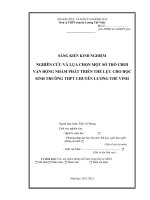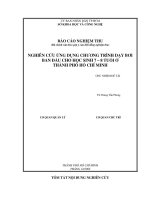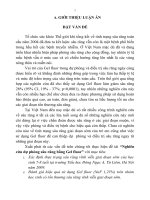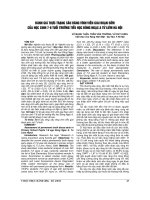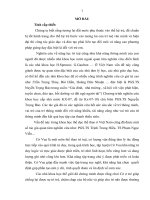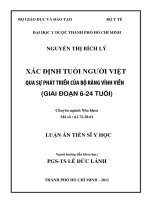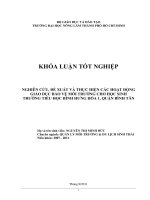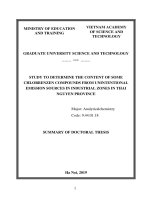Nghiên cứu dự phòng sâu răng vĩnh viễn giai đoạn sớm bằng nước xúc miệng fluor cho học sinh 7 8 tuổi ở tỉnh phú thọ tt tiếng anh
Bạn đang xem bản rút gọn của tài liệu. Xem và tải ngay bản đầy đủ của tài liệu tại đây (602.85 KB, 27 trang )
MINISTRY OF EDUCATION AND TRAINING MINISTRY OF DEFENCE
108 INSTITUTE OF CLINICAL MEDICAL AND PHARMACEUTICAL SCIENCES
-------------------------------------------------
TRAN THI KIM THUY
RESEARCH ON THE PREVENTION OF INCIPIENT CARIES
WITH FLUORIDE ORAL RINSING SOLUTION FOR 7-8
YEAR-OLD PUPILS IN PHU THO PROVINCE
Speciality: Odonto Stomatology
Code: 62720601
ABSTRACT OF MEDICAL PHD THESIS
Hanoi – 2019
THE THESIS WAS DONE IN: 108 INSTITUTE OF CLINICAL
MEDICAL AND PHARMACEUTICAL SCIENCES
Supervisor:
1. Prof. PhD. Trinh Dinh Hai
2. Ass. Prof. PhD. Le Thi Thu Ha
Reviewer 1:
Reviewer 2:
Reviewer 3:
This thesis will be presented at Institute Council at: 108 Institute of
Clinical Medical and Pharmaceutical Sciences
Day
Month
Year
The thesis can be found at:
1. National Library of Vietnam
2. Library of 108 Institute of Clinical Medical and
Pharmaceutical Sciences
1
A- THESIS INTRODUCTION
RESEARCH STATEMENT
Dental caries has worldwide, and besides periodontal disease, been
considered as one of the two leading burdens for dental healthcare.
According to the WHO (World Health Organisation) oral and dental
healthcare report in 2003, dental caries has presented impact on 60-90%
pupils, and almost adults, in a big number ofindustrial countries, with
the highest incidence in some Asian and Latin America countries. In
Vietnam, the incidence has been maintained at a high level, and tended to
increase, especially in rural and mountainous areas.
The role of fluoride, in general,and of fluoride oral rinsing solution,
in particular, has been known and recognized as a means toreduce
incidence and seriousness of dental caries. A research by Marinho et al.
(2003), through a general analysis of intervention research, indicates that
fluoride0.05% oral rinsing solutionreduces 45% dental caries rate
(95%CI: 0.35 - 0.50). These studies, however, have many limitations
such as not providing an optimal using method (with high efficiency,
safety, and convenience) or suggestingan optimal dosage for each stage
of dental caries.
In Vietnam, there are many dental caries researches conducted
covering all ages of the population, but most of them have been confined
in possibility of advanced-stage dental caries diagnosis. Therefore
efficiency in prevention and treatment are still low. There have not been
many studies on early childhood caries in children as well the use of
0.05% fluorideoral rinsing solution in prevention and treatment from
these stages. The research "Research on the prevention of incipient caries
with fluorideoral rinsing solution for 7-8-year-old pupils in Phu Tho
province" has two goals:
1. Determine icipient caries in permanenr teeth and related factors
in 7-8 year old pupils at Dinh Tien Hoang and Tan Dan schools
in Phu Tho, 2015.
2. Assess the efficiency of prevention and treatment of incipient
caries in permanent teeth by the use of 0.05% fluorideoral
rinsing solution on pupils 7-8 years after 18 months.
2
THE URGENCY OF THE RESEARCH
The understanding of dental carious pathotogy, especially during
early stages, has been neglected to some extent. Elements relating to
dental caries, methods of detection, diagnosis and prevention by
fluorideoral rinsing solution to maintain permanent healthy teeth is
essential.
Establishing a proper plans for preventing and treatment dental
caries during the early stage of permanent teeth eruption, many updated
data as well the specific efficiency of 0.05% fluorideoral rinsing solution
on carious lesions are need to be studied.
PRACTICAL MEANING AND NEW CONTRIBUTIONS
1) Update the incidence of incipient caries in permanent teeth and
detect some factors related to dental caries in 7-8 year old pupils.
2) Effectiveness of
0.05% fluorideoral rinsing solution in
prevention and treatment to demineralization incipient caries in
permanent teeth (D1, D2) is very high.
3) Changing diagnosis criteria according to ICDAS system will help
managers with giving more effective methods to prevent dental caries.
4) A simple, safe and low cost fluorideoral rinsing solution
programme should be planned during primary school.
THESIS STRUCTURE
The thesis consists of 4 chapters: Chapter I: Overview, 35 pages.
Chapter II: subjects and research methods 25 pages. Chapter III Research
results 36 pages.Chapter IV: 35 pages discussion. The thesis has 35
tables, 03 diagrams, 08 charts, 23 figures, 111 references, (27 in
Vietnamese, and 84 in English)
B. THESIS CONTENT
CHAPTER 1. AN OVERVIEW
1.1. Characteristics of primary dentition, permanent dentition and
pediatric oral pathology
1.1.1. Characteristics of teeth and permanent teeth: There are 4 stages.
From Embryonic stage to 3 years old: fully erupted primary teeth.
From 3-6 years old stage: primary dentition
From 6-12 years old: mixed dentition
From 12-18 years old: permanent dentition
3
1.1.2. Microscopic characteristics of tooth enamel:
In children, the distance between the enamel prism is big because
the calcification stage has not finished, whereas in adults, the
mineralization process is completed, it is impossible to find the space.
1.1.3. Characteristics of pediatric oral pathology
The typical dental diseases in children are related closely to diet,
oral hygiene and oral prophylaxis.
1.2. Understandings about dental caries and early stage dental caries
1.2.1. Definitions of dental caries:
- Caries is infection of the hard tissue of the teeth, characterized by
demineralization of inorganic components and destruction of organic
components.
- Early childhood caries (ECC) in children is the presence of one or
more deep carious lesions (already form into holes or not yet) on any
primary teeth in 71 months old children or younger.
-Incipient caries is a reducing pH process which lead to
demineralization that enhances the distance between hydroxy apatite
crystals, demineralization starts under the enamel surface, clinical carious
lesions is lost 10% of minerals.
1.2.2. Etiology of dental caries
Dental caries is a multifactorial disease
1.2.3. Physiology of dental caries
1.2.4. Progression of carious lesions:
The time for a lesion to progress from incipient caries to clinical
deep hole take several months up to over 2 years, depending on the
balance between demineralization and mineralization.
1.2.5. Classification of dental caries:
Classification by "site and size", by Pitt's diagnostic threshold and
by ICDAS are often applied in scientific research and community.
1.2.6. Diagnosis of dental caries:
There are many methods used to diagnose dental caries, each
methods have different diagnostic threshold and different diagnostic
criteria such as: visual examination, bitewing x-ray, electronic checking
machine (ECM), Fluorescent laser diagnosis (DIAGNODENT), digital
imaging fiber optic transillumination (DIFOTI), Quantitative Lightinduced of fluorescence (QLF), caries detection dyes, digital photos.
1.2.7. Epidemiology of dental caries and early stage dental caries in
children
1.2.7.1. Worldwide: early 21st century, dental caries is still a dental
health problem in most industrialized countries, affecting 60-90% of
pupils and most adults.
4
1.2.7.2. In Vietnam
The rate of dental caries in our country is still high and tends to
increase.
1.2.8 Management and prevention of dental caries
1.2.8.1. Management of dental caries: Controlling the risk of dental
caries is essential.
1.2.8.2. Intervention measures: In 1984, WHO introduced measures to
prevent dental caries with flour, fissure sealant, diet, oral hygiene, use of
antimicrobial substances.
1.3. The role of fluorideoral rinsing solution in prevention of early
stage dental caries in permanent teeth of children
1.3.1. Mechanism of flour oral rinsing solution:
- Strengthen tooth enamel, resist demineralization and increase
mineralization.
- Resist the erosion of enamel.
1.3.2. Studies on fluorideoral rinsing solution.
- Foreign reseacrh: the research has demonstrated and clarified the
mechanism of caries prevention of fluorideoral rinsing solution,
effectively reducing the rate of dental caries. There are still some
limitations for example; the best time to use oral rinsing solution and a
safe, simple, effective method has not yet been provided. Therefore,
more research is needed to clarify this issue.
- Domestic research: 0.2% fluoride oral rinsing solution effective for
preventing dental caries in children.
1.4.Some key points of population and socio-economic situation in
Phu Tho province
1.4.1. Socio-economic characteristics and health care condition: Phu
Tho is a Northern midland and mountainous province, with poor medical
facilities and bad infrastructure.
1.4.2. Status of school dentistry programm in Phu Tho
Almost schoold in the province have not adopted a school dental
healthcare programme.
CHAPTER 2. SUBJECTS AND METHOD OF RESEARCH
2.1. The cross sectional research
2.1.1. Location and time
- Time: from 08/2015 to 12/2015.
- Location: Dinh Tien Hoang primary school and Tan Dan primary
school, Viet Tri city, Phu Tho Province; 108 Institute of Clinical Medical
and Pharmaceutical Sciences.
5
2.1.2. Subjects of research
-Inclusion criteria: Pupils in the age of 7-8 years old (grade 2th) are
researching at Dinh Tien Hoang and Tan Dan primary school (Viet Tri
city, PhuTho province) in 2015-2016, voluntarily participate and are
allowed by parents.
-Exclusion criteria:Pupils who are not in the age of 7-8 years old;
having orthodontic treatment with fixed braces; having primary dentition,
systemic diseases or acute oral diseases; not volutarily participate and not
allowed by parents.
2.1.3. Methods of research
* Research design: Cross Sectional Descriptive Research
* Sample size:
Sample size is calculated with the following formula:
n = Z (21− / 2 )
pq
DE
d2
- Where: n: sample size; Z(1-α/2):realibility coefficient, kept in 95%;p:
rate of incipient permanent dental caries rate of 7-8 years-old pupils (p =
78.8%) (research of Vu Manh Tuan 2013); q: estimated rate of nonincipient caries in permanent teeth of 7-8 years old pupils (q = 21.2%); d:
absolute precision (d = 5%); DE: design coefficient = 1.2.
- Sample size calculated according to the formula is 308. In fact, the
research was conducted on 444 pupils.
*Method for sample selection
- Step 1: Choose Dinh Tien Hoang and Tan Dan primary school.
- Step 2: Interview and select pupils with the student's and family's
consent.
2.1.4. Processing
2.1.4.1. Data collection techniques
- Training and standardize researchers on examination and using
fluorescent laser Diagnodent lights.
- Collecting data by using a questionnaire table and dental record.
2.1.4.2. Procedures for clinical examination
- Step 1: Instruct pupils to keep oral hygiene with tooth brush, P/S
toothpaste before examination.
- Step 2: Exam and detect dental caries by observation method
according to the criteria of ICDAS
6
-Step3: Exam, detect dental caries and demineralization by
Dianodent 2190 device.
2.2. The Intervention research
2.2.1. Location and time
- Time: from 01/2016 to 12/2018.
-Location: Dinh Tien Hoang and Tan Dan primary school (Viet Tri
city, Phu Tho Province); Institute of Clinical Medical and Pharmaceutical
Sciences 108.
2.2.2. Subjects
-Inclusion criteria: Pupils randomly chosenfrom the results of the
cross-sectional research must be required: having permanent teeth,
voluntarily participating (with approval papers from parents or
guardians).
- Exclusion criteria:Pupils that having primary dentition; receiving
topical fluouride treatment or already finished under 6 months; having
fluoride allergic history; taking medicine which cross-react with Fluor
such as Chlorhexidine are not chosen.
2.2.2 Research methods:
-Research design: Randomized controlled clinical intervention research.
-Research sample:
We based on the formula of sample size calculation
Where: n1=sample size for the intervention group (use 0.05% fluorideoral
rinsing solution), n2=sample size for control group (used 0.05%
fluorideP/S toothpaste for children);Z(1–α/2)= the reliability coefficient,
kept in 95% (=1.96);Z1-β=power (= 80%);p1= the rate of incipient caries
in intervention group after 18 months follow up is estimated 40%; p2 =
the rate of incipient caries in the control group after 18 months follow up
is estimated 55%; p = (p1 + p2)/2.
According to the formula, the minimum required sample size for
both of research groups is n1 = n2 = 168 pupils. However, to maintain
research ethics, we selected all children in grade 2th who are eligible for
the research. To avoid psychology confusing for the pupils during the
research, we chose all 2thgrade pupils of one school for the intervention
group, and2thgradepupils of another school for the control group.
(intervention group: n=197, the control group n=247). After the
examination, the sample size of both group (the intervention group
7
n=195 and the control group n=247) are larger than the minimum
sample size needed (n=168). Therefore, the sample size in the research is
satisfied scientifically.
2.2.3.Research progress
2.2.3.1. Procedure of intervention technique:
The control group: Brushing once a day in the morning in 4 minutes,
the schedule is maintained for 18 months.
The interference group: Rinsing with fluorideoral rinsing solution once a
day in the morning in 2 minutes, the schedule is maintains for 18 months.
Both schedule are fixed.
2.2.3.2. Indexes in intervention research
DMFT, DMFS index, efficiency index (EI), intervention index (InI)
2.3. Evaluation criteria in cross-sectional and intervence studies
2.3.1. Standards in evaluating dental caries
Using the standard of International clinical evaluation and detection
system ICDAS, combining with fluorescent laser Diagnodent pen 2190
to support the diagnosis, classification and recording of mineralization
level in enamel and dentin
2.3.2. Results
D0: non caries; D1, D2, D3: caries; D1, D2 incipient caries; D3:
advanced stage caries.
2.4. Processing and analysis:Data were input by EPI DATA 3.1 software,
analyzed by SPSS 20.0 software with medical statistical method.
2.5. Errors in research: Measures are applied to limit errors from
sample selection, measurement, recall bias to data processing.
2.6. Ethnicity in research:All the pupils participating in the research
were explained and allowed by their parrents and their school.
Examination processing, sterilization is guaranteed. No other tests were
conducted during the research. Free treatment will be given in any
student if their carious lesions get worse.
Chapter 3. RESEARCH FINDINGS
3.1. Status of incipient caries in permanent teeth and some related
elements in junior pupils 7-8 years-old
3.1.1. Characteristics of the research objects: Among 444 pupils
researched, the female rate accounts for 50.2%, higher than that of the
male, 49.8%. Particularly, in Dinh Tien Hoang Junior School the male
rate, 51.8%, is higher than the female rate, 48.2%, while in Tan Dan
Junior School the status is opposite with the female, 52.8%, higher than
8
the male, 47.2%. But the difference between the rates of male and
female presents no statistically significance with p>0.05.
3.1.2. Permanent dental caries status
3.1.2.1. Permanent dental caries rates
χ2test: p1<0.01; p2>0.05; p3<0.001
Chart 3.5. Pupil permanent dental caries rates by schools (n=444)
Averagely, permanent dental caries rate of the two junior schools
is 57.9%, in which early decay rate (D1, D2) is very high and accounts
for the majority (56.1%), the rate of late tooth decay (D3) low percentage
(8.3%).
Table 3.4. Lesiond-level incipient caries rate by schools
School
Dinh Tien
Tan Dan
General
Hoang
p
Level
Rate
Rate
Rate (χ2 test)
n
n
n
(%)
(%)
(%)
Incipient
104
42.1
87
44.2 191
43.0
>0.05
carious stage D1
Incipient
54
21.9
73
37.1 127
28.6 <0.001
carious stage D2
Lately carious
19
7.7
18
9.1
37
8.3
>0.05
stage D3
p (χ2 test)
<0.01
<0.01
<0.01
Lately permanent dental caries D3 (with cavities formed clinically)
accounts for 8.3%, and increases up to 28.6% for lesions level D2 (color
changing in wetted teeth and laser index >20). Dental caries rate takes
the strongest rise in incipient carious lesion D1 (43.0% - color changing
9
after drying 5 second and laser index > 13). Difference of lesion-level
dental caries rate presents a statistically significance with p<0.01.
Table 3.6. Diagnosis-threshold permanent dental caries rate of detected
lesions
School Dinh Tien
Tan Dan
General
Hoang
p
Diagnosis
Rate
Rate
Rate (χ2 test)
n
n
n
thresholds
(%)
(%)
(%)
From D1 – D3
124 50.2 133
67.5
257 57.9 <0.001
From D2 – D3
60
2.3
79
40.1
139 31.3 <0.001
From D3
19
7.7
18
9.1
37
8.3
>0.05
Permanent dental caries rate when the lesions form cavities clinically
(from D3) accounts for 8.3%, and increases to 31.3% if the carious lesions are
treated from D2 level (Color changing of wetted teeth and laser index >20).
Dental caries rate takes the highest number when the incipient caries D1 (teeth
is changed in color after 5 second of drying and laser index >13) is included.
Difference of dental caries rate by diagnosis thresholds of D1 and D2 present
a statistically significance with p<0.001.
3.1.2.2. DMFT and DMFS indexes
Table 3.7. DMFT index by schools
Index (mean ± SD)
Schools
D1T
D2T
D3T
DT
MT
FT
DMFT
Dinh Tien
1.2±1.7 0.5±1.2 0.1±0.5 1.8±2.2 0.0
0.02±0.3 1.8±2.2
Hoang
Tan Dan 1.2±1.8 0.9±1.4 0.2±0.6 2.3±2.2 0.0 0.02±0.3 2.3±2.2
General 1.2±1.8 0.7±1.3 0.2±0.6 2.0±2.2 0.0 0.02±0.3 2.1±2.2
>0.05 <0.001
>0.05
<0.01
>0.05
<0.01
p
(p: Mann-whitney test)
DMFT index of the research object is 2.1±2.2, in which the index
of Tan Dan junior school’s pupils (2.3±2.2) is higher than that of Dinh
Tien Hoang school (1.8±2.2), presenting a statistically significant
difference with p<0.01. DT parameter (average of decayed teeth 2.0±2.2)
takes the main part of DMFT index, in which D1T parameter (Dental
caries D1 1.2±1.8) is the highest one. Average of decayed teeth of Tan
Dan school’s pupils (2.3±2.2) is higher than that of Dinh Tien Hoang
school’s pupils with a statistically significant difference of p<0.001.
10
Schools
D1S
Table 3.9. DMFS index by schools
Indexes (mean ± SD)
D2S
D3S
DS
MS
FS
DMFS
Dinh Tien
1.2±1.8 0.6±1.3 0.2±0.6 1.9±2.4 0.0 0.02±0.3 1.9±2.5
Hoang
Tan Dan 1.5±2.6 1.0±1.6 0.2±0.7 2.7±2.9 0.0 0.02±0.3 2.7±2.9
General 1.4±2.2 0.8±1.5 0.2±0.6 2.3±2.7 0.0 0.02±0.3 2.3±2.7
p
>0.05 <0.001 >0.05
<0.01
>0.05
<0.01
(p: Mann-whitney test)
DMFS index of the research object is 2.3±2.7, in which the index
of Tan Dan junior school’s pupils (2.7±2.9) is higher than that of Dinh
Tien Hoang school’s pupils (1.9±2.5). The difference of DMFS
indexesbetween the two schools makes a statistically significance with
p<0.01. DS parameter (average of decayed surfaces 2.3±2.7) takes the
main part of DMFS index, in which D1S parameter (decayed tooth surface
D1: 1.4±2.2) is the highest one. Average of decayed tooth surface number
of Tan Dan school’s pupils (2.7±2.9) is higher than that of Dinh Tien
Hoang school’s pupils 1.9±2.4 with a statistically significant difference of
p<0.01.
3.1.2.3. Some dental caries related elements
Table 3.14. Some elements relating to dental caries status and incipient
caries through multivariate regression analysis
Dental caries
Incipient caries
Indicatings
OR
95%CI
Yes
No
1
1
Chalky white spots No
on dental surface
Yes
3.13 1.61-6.08 3.49 1.79-6.80
1
1
Visible dental plates No
on teeth
Yes
1.12 0.58-2.18 1.30 0.67-2.51
No
1
1
Regularly noshing
Yes
1.45 0.77-2.75 1.36 0.72-2.59
No
1
1
Teeth with deep
fissures
Yes
4.53 1.79-11.42 4.45 1.80-11.04
Brushing with
No
1
1
fluoride toothpaste at
Yes
0.37 0.23-0.58 0.34 0.21-0.54
least twice a day
Multivariate regression analysis indicates that the elements of
chalky white spots on dental surface, teeth with deep fissures and
11
brushing with fluoride toothpaste at least twice a day, are closely related
to dental caries and incipient caries status, among which the element of
teeth with deep fissures is the strongest factor (increasing dental caries
risk 4.54 times and incipient caries risk 4.45 times). The dental caries
risk is reduced 0.37 times, and incipient caries 0.34, in the pupils
brushing with fluoride toothpaste at least twice a day.
3.2. Fluoride (NaF 0.05%) oral rinsing solution for incipient
permanent dental caries
3.2.1. Dental caries rate changing
Table 3.17. Incipient caries rate D1, D2 changingof the two groups by time
Incipient caries rate D1, D2
PreAfter 6
intervention months
n (%)
n (%)
After 12
months
n (%)
After 18
months
n (%)
Male
(n=93)
64 (68.8)
65
(69.9)
37
(40.7)
32
(35.2)
Interven
tion
Female
group (n=104)
(n=197)
64(61.5)
75
(72.1)
46
(44.2)
44
(42.3)
Total
128 (65.0)
140
(71.1)
83
(42.6)
76
(39.0)
Male
(n=128)
59
(46.1)
74
(57.8)
83
(64.8)
89
(69.5)
Control
group Female
(n=247) (n=119)
62
(52.1)
85
(71.4)
94
(79.0)
86
(72.3)
p
(prtest
test)
p12 > 0.05
p13<0.001
p13<0.001
p12 > 0.05
p13 < 0.01
p14 < 0.01
p12 > 0.05
p13<0.001
p14<0.001
p12 < 0.05
p13 < 0.01
p14>0.001
p12 < 0.01
p13<0.001
p14<0.001
121
159
177
175
p < 0.001
(49.0)
(64.4)
(71.7)
(70.9)
p1<0.01 p1>0.05
p1<0.001
p (χ2 test)
p2>0.05 p2>0.05 p<0.001 p2<0.001
p3<0.01 p3>0.05
p3<0.001
In the control group, incipient caries rate (with lesion levels D1
and D2) increases from 49.0% pre-intervention up to 64.4% after 6
Total
12
months, 71.7% after 12 months, and 70.9% after 18 months, in both the
male and female. The difference between incipient caries rate of preintervention and after 6, 12, and 18 months of intervention indicates a
statistically significance with p<0.001. Meanwhile, the incipient caries
rate of the intervention group (with lesion levels of D1 and D2) also
increases from 65.0% pre-intervention up to 71.1% after 6 months, then
decreases down to 42.6% after 12 months, and 39.0% after 18 months of
intervention. The rates also decrease in both the male and female after 12
and 18 months of intervention, and indicates a statistically significant
difference with p<0.001.
Table 3.18. Rate of advanced-stage tooth decay D3 changing in the the
two groups by time
Advanced-stage tooth decay rate D3
p
PreAfter 6 After 12 After 18
(prtest
intervention months months
months
test)
n (%)
n (%)
n (%)
n (%)
p12 > 0.05
10
16
21
19
Male
p13
< 0.05
(n=93)
(10.8)
(17.2)
(23.1)
(20.9)
p14 < 0.05
Interve
p12 > 0.05
ntion
8
14
28
30
Female
p13<0.001
(n=104)
group
(7.7)
(13.5)
(26.9)
(28.9)
p14<0.001
(n=197)
p12 < 0.05
18
30
49
49
Total
p13<0.001
(9.1)
(15.2)
(25.1)
(25.1)
p14<0.001
p12 < 0.05
9
19
31
50
Male
p13<0.001
(n=128)
(7.0)
(14.8)
(24.2)
(39.1)
p14<0.001
Control
group
10
29
44
58
Female
p < 0.001
(n=247) (n=119)
(8.4)
(24.4)
(37.0)
(48.7)
19
48
75
108
Total
p < 0.001
(7.7)
(19.4)
(30.4)
(43.7)
p1>0.05
p1 < 0.01
2
p(χ test)
p>0.05
p2<0.05 p>0.05 p2 < 0.01
p3>0.05
p3<0.001
In the control group, advanced-stage tooth decay rate (in lesion
level D3) increases from 9.1% pre-intervention up to 19.4% after 6
months, 30.4% 12 months, and 43.7% 18 months of intervention, in both
13
the male and the female. Differences of advanced-stage tooth decay rates,
pre-intervention and after 6, 12, 18 months, in both the male and the
female, indicate a statistically significance. In the intervention group, at
the same time, advanced-stage tooth decay rate (in lesion level D3),
increases from 7.7% pre-intervention up to 15.2% after 6 months, and
25.1% after 12 months, and remains the same after 18 months of
intervention. In both the male and female increases happen after 6 and 12
months, presenting a statistically significant difference with p<0.001.
Table 3.19. Dental caries rate changing of the two groups over time
Preintervention
n (%)
Dental caries rate
After 6 After 12 After 18
months months months
n (%)
n (%)
n (%)
p
(prtest
test)
p12 < 0.05
p13<0.001
p14<0.001
Male
(n=128)
61
(47.7)
77
(60.2)
93
(72.7)
97
(75.8)
Female
(n=119)
63
(52.9)
124
(50.2)
92
(77.3)
169
(68.4)
100
(84.0)
193
(78.1)
102
(85.7)
199
(80.6)
Male
(n=93)
67
(72.0)
68
(73.1)
49
(52.7)
46
(49.5)
Intervention
Female
group
(n=104)
(n=197)
p12 > 0.05
p13 < 0.01
p14<0.001
66
(63.5)
77
(74.0)
59
(56.7)
60
(57.7)
p > 0.05
133
(67.5)
145
(73.6)
108
(54.8)
106
(53.8)
p12 > 0.05
p13 < 0.01
p14 < 0.01
Control
group
(n=247)
Total
Total
p(χ2 test)
p1<0.001
p2 > 0.05
p3<0.001
p < 0.001
p < 0.001
p1<0.05 p1 < 0.01
p2>0.05 p2<0.001 p<0.001
p3>0.05 p3<0.001
In the control group, dental caries rate of pre-intervention
increases from 50.2% up to 68.4%, 78.1% and 80.6% after 6, 12 and 18
months of intervention, respectively, in both the male and the female.
The differences of dental caries rate after 6, 12, and 18 months of
intervention, in both the male and the female, indicate a statistically
significance. In the other group, such rate also increases from 67.5% up
to 73.6% after 6 months, then goes down to 54.8% and 53.8% after 12
and 18 months of intervention, respectively, in both the male and the
female, and indicates a statistically significant difference with p<0.001.
14
Table 3.22. Dental caries rate changing effectiveness by each level of
the two groups after 18 months of intervention
Groups
Dental
caries
D1
D2
D3
D1,2
D1,2,3
The intervention
PreAfter 18
intervention
months
n
%
n
87
73
18
128
133
44,2
37,1
9,1
65,0
67,5
56
38
49
76
106
%
EI
The control
PreAfter 18
intervention
months
n
28,7
35,1 104
19,5
47,4 54
25,1 175,8* 19
39,0
40,0 121
53,8
20,3 124
%
n
%
42,1
21,9
7,7
49,0
50,2
83
133
108
175
199
33,6
53,9
43,7
70,9
80,6
EI
InI
20,2 14,9
146,1* 193,6
467,5* 291,7
44,7* 84,7
60,6* 80,9
p(Prtest)<0.001; (*): Effective index decreases
After 18 months of intervention, in the control group, dental caries
rate increases from 50.2% up to 80.6%, indicating a decrease of 60.6% in
effective index; in which incipient caries rate (level D1 and D2) increase
from 49.0% up to 70.9%, the effective index also decreases 44.7%.
advanced-stage tooth decay rate (level D3) increases from 7.7% up to
43.7% corresponding to a significant decrease of 467.5% in effective
index. In the intervention group, dental caries rate decreases from 67.5%
down to 53.8%, and indicates a decrease of 20.3% in effective index; in
which, incipient caries rate decreases (levels D1 and D2) decreases from
65.0% down to 39.0%, corresponding to an increase of 175.8% in
effective index. The intervention index (D1, D1, and D3) increases
80.9%; incipient caries rate increases 84.7%; and the advanced-stage
tooth decay rate 291.7%.
3.2.2. Changes of DMFT and DMFS indexes
Mann-whitney test: p1<0.01, p2>0.05, p3,4<0.001
The control group: p12, p13, p14<0.001
The intervention group: p12>0.05, p13<0.01, p14<0.05
Chart 3.7. DMFT index changing according to the intervention group
15
In the control group, the DMFT index increases from 1.8 up to 2.6
after 12 months, and 3.4 after 18 months. In the intervention group, the
index takes a slight increase from 2.3 pre-intervention to 2.5 after 6
months, then a decrease of 1.8 after 12 months, and 1.9 after 18 months.
DMFT index differences between the two group at moments of 12 and 18
months indicate a statistically significant difference with p<0.001.
Table 3.27. DMFT index changing effectiveness of the two groups after
18 months of intervention
Groups
The intervention
The control
InI
PreAfter 18
PreAfter 18
intervention months
intervention months
EI
EI
Index
Mean ± SD
Mean ± SD
D1T
1.2 ± 1.8
0.7 ± 1.6
41.7 1.2 ± 1.7 0.9 ± 1.6
25.0 16.7
D2T
0.9 ± 1.4
0.4 ± 0.9
55.6 0.5 ± 1.2 1.3 ± 1.6 160.0* 215.6
D3T
0.2 ± 0.6
0.6 ± 1.3 200.0* 0.1 ± 0.5 1.2 ± 1.7 1100.0* 900.0
DT
2.3 ± 2.2
1.7 ± 2.4
26.1 1.8 ± 2.2 3.3 ± 2.7
83.3* 109.4
DMFT
2.3 ± 2.2
1.9 ± 2.5
17.4 1.8 ± 2.2 3.4 ± 2.6
88.9* 106.3
p(Prtest)<0.001; (*): Effective index decreases
After 18 months of intervention, in the control group DMFT index
increase from 1.8 up to 3.4, corresponding to a decrease of 88.9% in
effective index. In the intervention group, the index decreases from 2.3
down to 1.9, corresponding to an increase of 106.3% in effective index.
Differences of effective index upon average of decay, missing, and filled
teeth between the two groups, and of intervention effectiveness between
the means of decayed teeth in each lesion level, indicate a statistically
significant difference with p<0.001.
Mann-whitney test: p1<0.01, p2>0.05, p3,4<0.001
Nhóm chứng: p12, p13, p14<0.001
Nhóm can thiệp: p12>0.05, p13<0.01, p14<0.05
Chart 3.8. DMFS index changing by the intervention group
16
In the control group, DMFS index takes increases from 1.9 up to
2.8 after 6 months, 3.6 after 12 months, and 4.0 after 18 months. In the
intervention group, the index remains during 6 months of intervention,
then decreases from 2.7 down to 1.9 after 12 months, and 2.1 after 18
months. The difference of DMFT indexes between the two groups at
moments of 12 and 18 months indicate a statistically significant
difference.
Table 3.32. Effectiveness of DMFS index changing of the two groups
after 18 months of intervention
Groups
The intervention
The control
PreAfter 18
PreAfter 18
InI
intervention months
EI intervention months
EI
Index
Mean ± SD
Mean ± SD
1.5
±
2.6
0.8
±
1.7
1.2
± 1.8 1.1 ± 2.4
8.3 38.3
D1S
46.7
1.0 ± 1.6 0.4 ± 1.1
D2S
60.0 0.6 ± 1.3 1.6 ± 2.4 166.7* 226.7
0.2 ± 0.7 0.7 ± 1.4 250.0* 0.2 ± 0.6 1.4 ± 2.4 600.0* 350.0
D3S
2.7 ± 2.9 1.9 ± 2.6
DS
29.6 1.9 ± 2.4 4.0 ± 4.3 110.5* 140.2
DMFS 2.7 ± 2.9 2.1 ± 2.7 22.2 1.9 ± 2.5 4.0 ± 4.2 110.5* 132.7
p(Prtest)<0.001; (*): Effective index decreases
After 18 months, DMFS index of the control group strongly
increases from 1.9 up to 4.0, corresponding to a decrease of 110.5% in
effective index. In the intervention group, the DMFS index decreases
from 2.7 down to 2.1, resulting to an increase of 22.2% in effective
index. Intervention effectiveness between the intervention group and the
other over DMFS index increases 132.7%. Effective indexes between the
two groups indicate a statistically significant difference with p<0.001.
Chapter 4. DISCUSSION
4.1. Some characteristics of the research sample: the research is
conducted upon 444 pupils of 7-8 years-old who engage in rather
uniform conditions such as living conditions, educational and healthcare
environment. The research sample size is defined randomly and big
enough to characterize dental caries status of the pupils with the same
age and conditions.
17
4.2. Incipient permanent dental caries and some related elements
4.2.1. Dental caries status
*General permanent dental caries rate (including dental caries in
levels D1, D2, and D3)
Results exposed by Chart 3.5 shows that permanent dental caries
rate is 57.9%, in which dental caries rate of Tan Dan junior school’s
pupils (67.5%) is higher than that of Dinh Tien Hoang junior school’s
pupils (50.2%). Such a rate is a high one because the newly permanent
teeth of this age are mainly teeth No.6 and incisors. Our research matches
in results with works of other domestic as well as foreign researchers.
The results, even if being drawn from various researches conducted at
different times, different places and different ages of pupils, reveal a high
rate of junior dental caries rate.
A research of Tran Van Truong et al. in the task of national oral
and dental healthcare investigation 2001, showed that permanent dental
caries rate of 6-8 years-old pupils was 25.4%, and increased in 9-11
years-old pupils (54.6%). A research of Tran Thi My Hanh, 2006, Hanoi,
conducted in Hanoi over pupils of 7 and 11 years-old, showed that dental
caries rate of 7 years-old pupils was 17.0%, and of 8 years-old 49.3%,
both lower than that of our research. The reason for the differences, by
our treatment, and similar with Tran Van Truong’s work, 2011, is the
fact that the dental caries examination criteria applied in Tran Thi My
Hanh’s research is according to guidelines of WHO, 1997, which treats
dental caries happens when cavities are formed clinically, while that of
us is based on International Caries Detection and Assessment System
(ICDAS) supported by fluorescent laser. Thus, caries lesion, can be
avoided optimally, especially incipient caries which is not mentioned in
Tran Van Truong’s and Tran Thi My Hanh’s researches. A research of
Vu Manh Tuan, 2013, over 320 pupils 7-8 years-old in Dong Nga A
junior school, Hanoi city, applied ICDAS supported with Diagnodent as
in our own research. The results showed that incipient permanent dental
caries rate of 7-8 years-old pupils remained at a very high level: 78.8%;
DMFT index was 2.21 ± 1.52. This result was higher than that of us, but
time of that research was 6 years earlier than that of us. By time and
social development, our country economic conditions have been
improved, oral and dental care has made better, thus reduced dental
caries rate against the past.
18
Some other foreign researches have also showed a high level of
permanent dental caries rate. Results from Faraz A. Farooqi et al. (2015),
cross sectional research over 711 children from 6-12 years-old, in
Dammam, Saudi Arabia, showed that permanent dental caries rate
remained at almost 73%. Do LG at el. (2015) made a research on 2214
children 5-8 years-old and 3186 9-14 years-old in Queensland which
showed that permanent and delicious dental caries rates was 47.1% and
38.8%, respectively. Children in the region lacking fluoridated water
suffered a higher dental caries rate against the counter region. Lacking
fluoride makes dental caries rate increase 21% in delicious teeth, and
31% in permanent ones for children.
* Permanent dental caries rate by lesion level
Permanent dental caries rate when lesions causing cavities
clinically (from level D3) accounts for 8.3%, and increase up to 31.3% if
the carious lesions are treated from D2 level (color changing in wetted
teeth and laser index >20). Dental caries rate increases up to 57.9% if
carious lesions include also D1 stage (color changing happened after
drying 5 seconds and laser index >13) (Table 3.6). These results show
that in case of clinical reexamination without support means, such as
fluorescent laser, it is extreme easy to leave carious lesions unchecked,
especially lesions in levels D1 and D2 which are different slightly in
vision checking of dried or wetted tooth surface (when applied
examination and diagnosis criteria of ICDAS). Missing possibility is very
high, almost 50%, when applying dental caries recognition criteria of
WHO (1997) which treats only lesions causing cavities and tugging-back
with explorer as dental caries. Permanent dental caries rate by levels in
our research is lower than that in the research of Tran Thi Ngoc Bich et
al. In our research, with ICDAS applied, shows that: in S3 level (caries
on dentin with cavities formed) dental caries rate is 67.1%, and in S1
(Dental caries classes I and II by ICDAS), 99.3%. A research of Nguyen
Thi Mai, 2012, over 555 pupils 7-11 years-old in Hoang Mai district,
Hanoi showed that permanent dental caries rate was 54.8% with visual
examination according to UCDAS II. Dental caries rate of the first molar
tooth by WHO criteria 1997 was 30.6%, while by ICDAS II 33.6%, and
while being supported with fluorescent laser 80.0%.
19
* DMFT and DMFS indexes
DMFT index in the research is 2.1±2.2, in which dental caries
parameter (mean of decayed teeth 2.0±2.2) takes the main part of DMFT
index. D1T (dental caries level D1) takes the highest place (Table 3.7). In
comparison, the national oral and dental healthcare investigation 2011
has a DMFT index of 6-8 years-old, 0.48, lower than that of our
research. The reason can be the difference of dental caries status
recognition methods. DMFT index in our research is also higher than that
of the research of Vu Manh Tuan et al., 2011, in Quang Binh (1.91). The
reason comes from application of fluorescent laser in our research which
helps avoid a common mistake of missing incipient carious lesions in
visual checking. Our research in return is lower than the results of Khan
SQ’s research (2014). In generalizing and analysing 293 researches of
dental caries status in Saudi Arabia, the results shows that DMFT index
of delicious teeth is 4.341 (children from 2 to 12 years-old), and of
permanent ones 2.469 (children 6-20 years-old).
DMFS in the research is 2.3±2.7. DS parameter (average carious
tooth surfaces: 2.3±2.7) accounts for the main part of DMFS index
(Table 3.9). In comparison with Tran Van Truong’s research, 2001, the
basic national investigation over 706 children 6-8 years-old shows
DMFS of 0.60; DS 0.59; MS 0.00 and FS 0.01. The research does reveal
D1S, D2S, or D3S because of applying WHO examination criteria.
DMFS index in our research is lower than that of Vu Manh Tuan’s
research, 2013 (2.83±2.23).
4.2.2. Some related elements
In multivariate regression analysis, we realize that elements of
chalky white spots on dental surface, teeth with deep fissures and
brushing with fluoride toothpaste at least twice a day, are closely related
to dental caries and incipient caries status, among which the element of
teeth with deep fissures is the strongest factor (increasing dental caries
risk 4.54 times and incipient caries risk 4.45 times). Chalky white spots
on dental surface increases dental caries risk up to 3.13 times and the
incipient caries risk 3.49. The dental caries risk is reduced 0.37 times,
and incipient caries 0.34, in the pupils brushing with fluoride toothpaste
at least twice a day. A research of Tran Tan Tai (2016) over pupils of
some junior schools in Thua Thien Hue showed that: the pupils brushing
their teeth less than triple a day suffered a dental caries risk 5.32 times
higher than the counter pupils; the pupils practising habit of noshing
20
sweet foods suffered a dental caries risk 6.14 times higher than that of the
counter pupils. Mulu W. et al., 2014, conducted a research over 147
pupils of a junior school in Bahir Dar, Ethiopia. The results showed that
dental caries factors was: a bad habit of oral and dental hygiene in junior
pupils such as non-brushing, non-oral rinsing, dental plates and toothache
4.3. Effectiveness of oral cleaning solution with fluoride (NaF 0.05%)
included against incipient permanent dental caries through
intervention research
4.3.1. Intervention effectiveness presented by dental caries rate
changing
Before intervention, dental caries rate of the control group is
50.2%, then increases up to 68.4%, 78.1% and 80.6% after 6, 12 and 18
months of intervention, respectively. In the other group, such rate also
increases from 67.5% up to 73.6% after 6 months, then goes down to
54.8% and 53.8% after 12 and 18 months of intervention, respectively.
The differences of dental caries rate between the two group indicate a
statistically significant difference with p<0.001 (Table 3.19). Through
the results we can say that the longer intervention time is, the lower
dental caries rate is reduced, proving effectiveness of fluoride 0.05% oral
rinsing solution, but at the same time the research fails to suggest an
optimal period of intervention to erase completely dental caries rate.
Such suggestion can be impossible because many research on fluoride
effects have demonstrated recovering ability of fluoride only for incipient
carious lesions (D1 and D2, corresponding to codes 1 and 2 in ICDAS),
not for cavity-forming lesions (D3, corresponding to codes 3-6 in
ICDAS). In such case, Fluoride can only help slow down caries
expansion.
As for incipient caries, the results showed in table 3.17 shows that:
In the control group, incipient caries rate increases from 49.0% preintervention up to 64.4% after 6 months, 71.7% after 12 months, and
70.9% after 18 months. Meanwhile, the incipient caries rate of the
intervention group also slightly increases from 65.0% pre-intervention up
to 71.1% after 6 months, then decreases down to 42.6% after 12 months,
and 39.0% after 18 months of intervention. Thus, a change of oral and
dental healthcare habit is insufficient because even if using additionally
toothpaste, the dental caries rate of the control group still increases, while
in the intervention group such rate clearly decreases after 12 and 18
months. Such a fact points out effective remineralization of fluoride oral
21
rinsing solution in prevention and treatment of incipient carious lesions.
As for lately carious lesions (D3), the results stated in Table 3.18 shows
an increase of advanced-stage tooth decay rate from 9.1% preintervention to 19.4%, 30.4%, and 43.7% after 6, 12, and 18 months,
respectively; such rate of the intervention group increases from 7.7% preintervention to 15.2% after 6 months, 25.1% after 12 months, and
remains the same after 18 months.
The rates also decrease in both the male and female after 12 and 18
months of intervention, and indicates a statistically significant difference
with p<0.001.
In comparison of dental caries prevention effectiveness between
fluoride oral rinsing solution and toothpaste, after 18 months, the
intervention between the intervention group and the control group
increases 80.9% against general dental caries rate, 84.7% against
incipient caries rate (D2 193.6%), and especially 291.6% against
advanced-stage tooth decay rate. Thus, after 18 months of intervention by
fluoride 0.05% oral rinsing solution, dental caries rate of 7-8 years-old
pupils, as showed in our research, decreases 13.7%; and incipient caries
rate (D1 and D2) decreases 26%. The results in our research is lower than
that of some researches over the world. A general research of Twetman
reported a dental caries rate decrease of 30% by applying the oral rinsing
solution. The decreases in a Yoshihara’s research is 76.1%, and
Kobayashi’s research 86% in a long-term programme. The difference of
dental caries rate decrease in our research from that of mentioned above
researchers comes from the way of examination; Twetman generalized
researches of fluoride 0.2% oral solution using; Yoshihara also used the
same during three years; especially Kobayashi it for a programme of 17
years. Thus in such researches, the pupils had time enough to form a
regular and continuous contact with stable fluoride ion in their mouths,
resulting in a decrease much stronger than the results of our 18 months
research with a fluoride solution just 0.05%. According to Marinho et al.,
oral rinsing solution helps reduce 26% dental caries rate in children
regardless kind of fluoride.
In Vietnam, in 2000, Trinh Dinh Hai et al. conducted a research
using NaF 0.2% for children 6-15 years-old in Hai Duong to rinse
weekly, in combination with oral and dental hygiene training. After 8
years, the permanent dental caries rate decreased 45%.
22
4.3.2. Intervention effectiveness through DMFT and DMFS indexes
changing
Research results showed in Charts 3.7 and 3.8 show that in the
control group, the DMFT index increases from 1.8 up to 2.6 after 12
months, and 3.4 after 18 months. In the intervention group, the index
takes a slight increase from 2.3 pre-intervention to 2.5 after 6 months,
then a decrease of 1.8 after 12 months, and 1.9 after 18 months. DMFS
index remains after 6 months of intervention, then decreases from 2.7
down to 1.9 after 12 months, and 2.1 after 18 months. In our results, if
explained by WHO guideline and applying diagnosis standard 1997,
DMFT index is a non-reversible index because DT or DS (average of
carious teeth or carious tooth surface) can not be annulled but transformed
into MT, MS (average of teeth or tooth surfaces missed by caries), or FT,
FS (filled teeth and tooth surfaces). Thus, DMFT and DMFS are
accumulated by time and non-reversible. In our research, however, due to
the examination by new criteria to detect incipient carious lesions, DT,
including D1T, D2T, and D3T, and DS, including D1S, D2S, and D3S, in
which D1T, D2T, and D1S, D2S can be remineralized and reversible
without filling application. Thus, if D1T, D2T and D1S, D2S decrease,
DMFT and MDFS decrease, also. After 18 months, intervention
effectiveness between the control group and the intervention group against
DMFT increases 106.3%, and against DMFS 132.7%.
Our results also match with that of some other researches, domestic
as well as foreign. A research of Aminabadi N.A., 2007, over 200 junior
pupils of Tabriz city, Iran showed that: DMFT of the fluoride 0.68 oral
rinsing group decreased 0.68 (51.5%) against the group using toothpaste
and dental thread. A general research of Marinho V.C.Cet al. (2016)
demonstrated that a regular practice of oral rinsing with fluoride solution
made DMFS in children decrease 27% averagely against a group using
placebo or not practicing oral rinsing with solution. Results of 13 other
intervention researches have pointed that fluoride oral rinsing solution
helped DMFT reduced 23% against a control group.
Reviewing results of Aminabadi N.A., Chen CJ-A, and especially
the general research of Marinho V.C.C, show that fluoride oral rinsing
solution reduces dental caries rate through decreases of DMFT and
DMFS indexes; these researches, however, fail to demonstrate a
suggested optimal period, and optimal concentration of the solution, to
reduce the most DMFT and DMFS indexes.
23
4.4. Research method
4.4.1. Research design and research sample inclusion
We apply two kinds of research: cross sectional descriptive research
and controlled random clinical intervention research, in which the later
provide more reliant and valuable evidence against the descriptive
research and analysis research (except a meta analysis method)
Sample size of the research is 444 pupils. In the intervention
research, the number maintains 442 pupils post-research. Sample sizes of
both kinds of research are bigger than the required minimum size, thus
ensure scientific certainty to present results of dental caries prevention
effectiveness of fluoride 0.05% oral rinsing solution (with sample
strength 80%). According to theory of epidemiology, a sample strength
of 80-90% is sufficient in reliance.
4.4.2. Means, techniques and materials used in the research
We chose Diagnodent device to assess dental carious lesions for
both cross sectional descriptive research and intervention research. Such
a device helps: ensuring objectiveness and reliance for diagnosis and
dental carious lesion observance, maximally removing difficulties for a
diagnosis to distinguish incipient caries D1 and D2.
4.4.3. Figures collection and analysis
Figures collected through examinations are coded and inputted into
the computer in two instalments, checked and compared to remove and
reduce maximally systematic error.
CONCLUSIONS
1. Incipient caries status and some related elements in pupils 7-8
years-old
- Incipient caries status
Incipient caries rate of pupils 7-8 years-old is on a high level: 57.9%
for dental caries determined from incipient carious lesion D1, 31.3%
from D2, and 8.3% from D3. DMFT index is 2.1±2.2, and DMFS index
2.3 ± 2.7.
- Some elements related and rising dental caries risk and incipient caries risk
+ Teeth with natural deep fissures suffer a dental caries risk 4.53
times (95%CI: 1.79-11.42), and incipient caries risk 4,45 times higher.
+ Visual chalky white spots on tooth can rise dental caries risk
3.13 times (95%CI: 1.61-6.08), and incipient caries risk 3,49 times
(95%CI: 1.79-6.80), (95%CI: 1.79-11.42)
+ Tooth brushing with fluoride toothpaste twice a day reduces 0.37
times dental caries risk (95%CI: 0.23-0.58), and incipient caries risk 0.34
times (95%CI: 0.21-0.54).
+ An evidence on relationship between visual carious cavities on
X-ray film, tooth brushing with fluoride toothpaste, and dental caries has
not been found.

